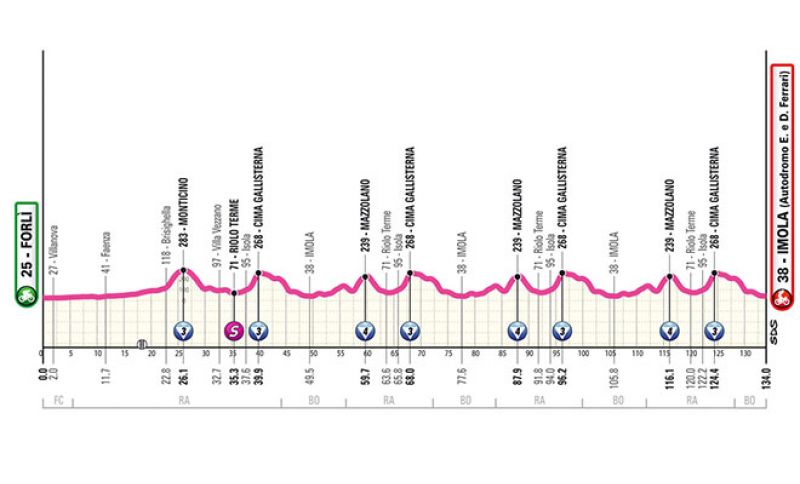

Anyone who thought that Monte Nerone could truly close the race must absolutely think again because the final stage - the 134 km Forlì-Imola - with the finish at the Enzo and Dino Ferrari racetrack is anything but predictable.
to follow the live coverage of the entire stage starting at 10:40 AM CLICK HERE
After a series of ups and downs, the peloton will enter the final circuit that we've already seen during the 2020 World Championships with the climbs of Mazzolano and Cima Gallistera. It will be repeated 4 times and will create great chaos. In Imola, a small group might arrive, or even a solo athlete, but one thing is certain: the winner of the Giro Women 2025 will be crowned in this famous racetrack.
THE TERRITORY. For the grand finale, the Giro Women returns to Romagna with a challenging stage that could offer surprises.
Spectators waiting for the athletes' passage will not be bored. Far from it. Forlì, often in the news for important art exhibitions at the San Domenico Museums Complex, which also houses the Civic Art Gallery, has much to show. For example, the Abbey of San Mercuriale in the central Aurelio Saffi square, the Ravaldino Fortress, a medieval fortified citadel expanded during the 15th century, and the Municipal Palace, dating back to the 14th century and renovated multiple times, with the towering Civic Tower (or Clock Tower).
Shortly after the start, the route enters Faenza, a city known worldwide since the Renaissance as the capital of artistic ceramics. The most renowned artisans and artists have worked here, and even today, masterpieces continue to emerge from the workshops of incredibly skilled masters.
A visit to the MIC (International Ceramics Museum) is mandatory, which houses the most extensive collection of majolica one could imagine: over 60,000 pieces from every era and from around the world are preserved in its halls. The heart of the city is Piazza del Popolo, with the 16th-century loggia of Palazzo Manfredi and the Podestà Palace, testifying to the political and administrative centrality of the place. Nearby, in Piazza della Libertà, the Renaissance Cathedral stands out with its raw brick facade.
Brisighella, one of the "Most Beautiful Villages in Italy" seduces with its medieval layout, appreciated while walking through the cobblestone maze of streets: unmissable is the ancient Via del Borgo, an elevated and covered street illuminated by arches of different widths, also known as the "Donkeys' Street" for providing shelter to the carts' animals. The village is situated at the foot of three gypsum pinnacles supporting the 15th-century Manfrediana Fortress, the 19th-century Clock Tower built on a previous 1290 fortification, and the 18th-century Monticino Sanctuary.
Riolo Terme invites visitors to relax in its thermal establishments. Why not? However, one must not forget the Sforza Fortress, the symbolic monument of the locality. Built around the 14th century, it has a quadrangular layout, imposing circular towers, perimeter walls typical of 16th-century fortifications, and a moat recovered around the 1980s.
The race concludes on the Imola Racetrack, dear to F1 and MotoGP enthusiasts. It will be spectacular, but it's worth visiting the city center dominated by the Sforza Fortress, a splendid example of fortified architecture between the Middle Ages and Renaissance. Of 14th-century layout, it owes its current appearance to defensive works conducted in the 15th century. Inside, the visit route allows admiring ancient defense means as well as a collection of about 600 pieces including white, defensive, and firearms weapons, ceramics, and tableware discovered during restoration work. Then it will be a celebration for everyone. And in Romagna, when it comes to having fun, they really know how to do it.

Se sei giá nostro utente esegui il login altrimenti registrati.